The Progress Notes form serves as a vital tool in medical record-keeping. It documents a patient's ongoing treatment and progress over time. This information is essential for healthcare providers to track the effectiveness of interventions and make informed decisions about future care.
Healthcare professionals involved in a patient's care are responsible for completing the Progress Notes form. This includes doctors, nurses, and therapists. Each entry should reflect their observations, assessments, and any changes in the patient's condition.
Key details must be included to ensure the form is complete. This includes:
-
Patient's full name (last, first, middle)
-
Grade, rank, or rate of the patient
-
Hospital or medical facility name
-
Patient's identification number and ward number
-
Date of the entry
How often should Progress Notes be completed?
Progress Notes should be filled out regularly, typically during each patient visit or whenever there is a significant change in the patient's condition. Consistency is key to maintaining an accurate and up-to-date medical record.
Can Progress Notes be completed electronically?
Yes, many healthcare facilities now allow for electronic completion of Progress Notes. This can enhance efficiency and improve the accessibility of patient records. However, it is essential to ensure that electronic systems comply with relevant privacy and security regulations.
If an error occurs, it is important to correct it properly. Cross out the mistake with a single line, and initial the correction. Avoid using white-out or erasing the error, as this could lead to confusion and questions about the accuracy of the record.
Are there specific guidelines for writing Progress Notes?
While guidelines can vary by institution, some general best practices include:
-
Be clear and concise in your writing.
-
Use objective language and avoid subjective opinions.
-
Document any assessments, interventions, and patient responses.
-
Ensure that entries are dated and signed by the person making them.
What is the importance of maintaining confidentiality in Progress Notes?
Confidentiality is crucial when handling Progress Notes. These documents contain sensitive patient information that must be protected to comply with privacy laws. Ensuring that only authorized personnel have access to these records helps maintain trust between patients and healthcare providers.
